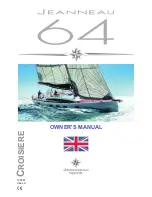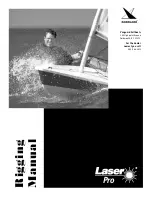
1-8
370 Outrage
R
Section 1 • Safety
Children and non-swimmers must wear a PFD
at all times when aboard.
All passengers
and crew should wear them since an unworn PFD is
often useless. The law requires that PFD’s, if not
worn must be readily accesible, that is, removed
from storage bags and unbuckled. Throwable devices
must be readily available, that is, right at hand.
General Considerations
• Know how your boat handles under different
conditions. Recognize your limitations and
the boat’s limitations. Modify speed in keeping
with weather, sea and traffi c conditions.
• Instruct passengers on location and use of
safety equipment and procedures.
• Instruct passengers on the fundamentals of
operating your boat in case you are unable to
do so.
• You are responsible for passenger’s actions. If
they place themselves or the boat in danger,
immediately correct them.
A qualifi ed operator must be in control of the
boat at all times. Do not operate the boat while
under the infl uence of alcohol or drugs. Never
operate your boat at speeds which exceed
the operator’s ability to react if an emergency
develops. At night, turn on the appropriate
navigation lights and cruise at a reduced speed
that will allow you plenty of time to avoid
dangerous situations.
!
WARNING
Listed below are the several different types of PFD’s,
each life jacket has different purposes, choose one
that will suit your purpose.
Type I
, Off-shore Life Jacket is
considered the most bouyant, it
is designed to turn an
unconscious person face up.
Use in all types of waters where
rescue may be slow, particularly
in cold or rough water condi-
tions.
Type II
, Near-shore Life Vest,
“keyhole” vest with fl otation
fi lled head and neck support is
also designed to turn a person
face up, but the turning action is
not as pronounced. Use in calm
inland waters or where quick
rescue is likely.
Type III
, Flotation-aid Life vest
is designed so that conscious
wearers can turn face-up.
Designed for comfort while
engaged in water skiing or other
forms of water activities.
Type IV
, Throwable Devices,
horseshoe bouys, ring bouys and
bouyant cushions are designed
to be grasped, not worn.
Type V
, Special-Use devices,
sailboat harnesses, white water
vests, fl oat coats, and hybrid
vests which have minimum
inherent bouyancy and an
infl atable chamber.
Before purchasing PFD’s, ensure that there is an
attached tag indicating they are approved by the
U.S.Coast Guard or by your National Boating Law
Enforcment Agency.
The operator is responsible for instructing everyone
onboard on the location and use of the PFD.
The
best precaution is to wear the PFD at all times
Summary of Contents for 370 Outrage
Page 2: ......
Page 20: ...xx 370 Outrage R THIS PAGE INTENTIONALLY LEFT BLANK...
Page 162: ...4 16 370 Outrage Section 4 Electrical System R Battery Diagram Sheet 1 Fig 4 16 1...
Page 164: ...4 18 370 Outrage Section 4 Electrical System R Helm Breaker Panel Sheet 3 Fig 4 18 1...
Page 168: ...4 22 370 Outrage Section 4 Electrical System R Windlass Schematic Sheet 7 Fig 4 22 1...
Page 170: ...4 24 370 Outrage Section 4 Electrical System R DC Distribution Panel Sheet 9 Fig 4 24 1...
Page 172: ...4 26 370 Outrage Section 4 Electrical System R Hardtop Scematic Sheet 11 Fig 4 26 1...
Page 180: ...4 34 370 Outrage Section 4 Electrical System R Bilge Wiring Schematic Sheet 19 Fig 4 34 1...
















































